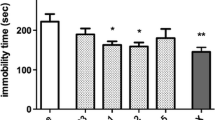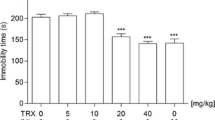Abstract
This study demonstrated that distinct patterns of active behaviors are produced by antidepressants that selectively inhibit norepinephrine (NE) or serotonin (5-HT) uptake in the rat forced swimming test (FST). A behavior sampling technique was developed to score the active behaviors swimming, climbing and diving, as well as immobility. The rat's behavior was recorded at the end of each 5-s period during the test session. The sampling technique was both reliable, as demonstrated by test-retest reliability and inter-rater reliability, and valid, as shown by comparison to the timing of behavior durations. Five different antidepressant drugs which block monoamine uptake and two 5-HT1A receptor agonists were shown to decrease immobility in the FST; however, they produced distinct patterns of active behaviors. The selective NE uptake inhibitors desipramine and maprotiline selectively increased climbing, whereas the selective serotonin reuptake inhibitors (SSRIs) fluoxetine, sertraline and paroxetine selectively increased swimming. The 5-HT1A receptor agonists 8-OH-DPAT and gepirone also selectively increased swimming. These results show that:1) SSRIs are not false negatives in the FST; 2) at least two behaviorally distinct processes occur in the FST; and 3) enhancement of NE neurotransmission may mediate climbing in the FST, whereas enhancement of 5-HT neurotransmission may mediate swimming.
Similar content being viewed by others
References
Abel EL (1991) Behavior and corticosteroid response of Maudsley reactive and nonreactive rats in the open field and forced swimming test. Physiol Behav 50:151–153
Altmann J (1974) Observational study of behavior: sampling methods. Behaviour 49:227–267
Armario A, Gavalda A, Marti O (1988) Forced swimming test in rats: effect of desipramine administration and the period of exposure to the test on struggling behavior, swimming, immobility and defecation rate. Eur J Pharmacol 158:207–212
Bolden-Watson C, Richelson E (1993) Blockade by newly-developed antidepressants of biogenic amine uptake into rat brain synaptosomes. Life Sci 52:1023–1029
Borsini F, Meli A (1988) Is the forced swimming test a suitable model for revealing antidepressant activity? Psychopharmacology 94:147–160
Cervo L, Grignaschi G, Samanin R (1990) α2-Adrenoceptor blockade prevents the effect of desipramine in the forced swimming test. Eur J Pharmacol 175:301–307
Cervo L, Grignaschi G, Rossi C, Samanin R (1991) Role of serotonergic neurons in the effect of sertraline in rats in the forced swimming test. Eur J Pharmacol 196:217–222
Delgado PL, Price LH, Miller HL, Salomon RM, Licinio J, Krystal JH, Heninger GR, Charney DS (1991) Rapid serotonin depletion as a provocative challenge test for patients with major depression: relevance to antidepressant action and the neurobiology of depression. Psychopharmacol Bull 27:321–330
Delgado PL, Miller HL, Salomon RM, Licinio J, Heninger GR, Gelenberg AJ, Charney DS (1993) Monoamines and the mechanism of antidepressant action: effects of catecholamine depletion on mood of patients treated with antidepressants. Psychopharmacol Bull 29:389–396
Detke MJ, Rickels M, Lucki I (1994) Differential behavioral responding to noradrenergic and serotonergic antidepressants in the forced swim test (FST). Soc Neurosci Abstr 20:385
Detke MJ, Wieland S, Lucki I (1995) Blockade of the antidepressant-like effects of 8-OH-DPAT, buspirone and desipramine in the rat forced swim test by 5-HT1A receptor antagonists. Psychopharmacology (in press)
Dunbar, RIM (1976) Some aspects of research design and their implications in the observational study of behavior. Behaviour 58:78–98
Gorka Z, Wojtasik E, Kwiatek H, Maj J (1979) Action of serotoninmimetics in the behavioral despair test in rats. Commun Psychopharmacol 3:133–136
Hjorth S, Sharp T (1990) Mixed agonist/antagonist properties of NAN-190 at 5-HT1A receptors: behavioural and in vivo brain microdialysis studies. Life Sci 46:955–963
Holland PC (1977) Conditioned stimulus as a determinant of the form of the Pavlovian conditioned response. J Exp Psychol [Anim Behav Proc] 3:77–104
Holland PC (1986) Temporal determinants of occasion setting in feature-positive discriminations. Anim Learn Behav 14:111–120
Kitada Y, Miyauchi T, Kanazawa Y, Nakamichi H, Satoh S (1983) Involvement ofα- andβ 1-adrenergic mechanisms in the immobility-reducing action of desipramine in the forced swimming test. Neuropharmacology 22:1055–1060
Leger DW (1977) An empirical evaluation of instantaneous and one-zero sampling of chimpanzee behavior. Primates 18:387–393
Lucki I, Ward HR, Frazer A (1989) Effect of 1-(m-chlorophenyl)-piperazine and 1-(m-trifluoromethylphenyl)-piperazine on locomotor activity. J Pharmacol Exp Ther 249:155–164
Lucki I, Singh A, Kreiss DS (1994) Antidepressant-like behavioral effects of serotonin receptor agonists. Neurosci Biobehav Rev 18:85–95
Maj J, Rogoz Z, Skuza G (1992) The effects of combined treatment with MK-801 and antidepressant drugs in the forced swimming test in rats. Pol J Pharmacol Pharm 44:217–226
Marti J, Armario A (1993) Effects of diazepam and desipramine in the forced swimming test: influence of previous experience with the situation. Eur J Pharmacol 236:295–299
Martin P, Bateson P (1993) Measuring behaviour: an introductory guide, 2nd edn. Cambridge University Press, New York: pp 90–91
Naitoh H, Nomura S, Kunimi Y, Yamaoka K (1992) “Swimming-induced head twitching” in rats in the forced swimming test induced by overcrowding stress: a new marker in the animal model of depression? Keio J Med 41:221–224
Nishimura H, Tsuda A, Oguchi M, Ida Y, Tanaka M (1988) Is immobility of rats in the forced swim test “behavioral despair” Physiol Behav 42:93–95
Nixon MK, Hascoet M, Bourin M, Colombel MC (1994) Additive effects of lithium and antidepressants in the forced swimming test: further evidence for involvement of the serotoninergic system. Psychopharmacology 115:59–64
Overstreet DH (1993) The Flinders sensitive line rats: a genetic animal model of depression. Neurosci Biobehav Rev 17:51–68
Pare WP (1989a) “Behavioral despair” test predicts stress ulcer in WKY rats. Physiol Behav 46:483–487
Pare WP (1989b) Stress ulcer susceptibility and depression in Wistar Kyoto (WKY) rats. Physiol Behav 46:993–998
Pare WP (1992) Learning behavior, escape behavior, and depression in an ulcer susceptible rat strain. Integr Physiol Behav Sci 27:130–141
Paul IA, Duncan GE, Kuhn C, Mueller RA, Hong J, Breese GR (1990) Neural adaptation in imipramine-treated rats processed in forced swim test: assessment of time course, handling, rat strain and amine uptake. J Pharmacol Exp Ther 252:997–1005
Porsolt RD (1981) Behavioral despair. In: Enna SJ (ed) Antidepressants: neurochemical, behavioral, and clinical perspectives. Raven Press, New York, pp 121–139
Porsolt RD (1990) Behavioral despair: present status and future perspectives. In: Leonard BE, Spencer PJ (eds) Antidepressants: thirty years on. CNS Publishers, London, pp 85–94
Porsolt RD, Lenegre A (1992) Behavioral models of depression. In: Elliot JM, Heal DJ, Marsden CA (eds) Experimental approaches to anxiety and depression. Wiley, New York, pp 73–85
Porsolt R, Le Pichon M, Jalfre M (1977) Depression: a new animal model sensitive to antidepressant treatments. Nature 266:730–732
Porsolt RD, Anton G, Deniel M, Jalfre M (1978) Behavioral despair in rats: a new model sensitive to antidepressant treatments. Eur J Pharmacol 47:379–391
Porsolt RD, Bertin A, Blavet N, Deniel M, Jalfre M (1979) Immobility induced by forced swimming in rats: effects of agents which modify central catecholamine and serotonin activity. Eur J Pharmacol 57:201–210
Porsolt RD, Lenegre A, McArthur RA (1991) Pharmacological models of depression. In: Animal models in psychopharmacology, B. Olivier, J. Slangen and J. Mos (eds). Birkhäuser, Basel, pp 137–159
Rhine RJ, Flanigon M (1978) An empirical comparison of one-zero, focal-animal, and instantaneous methods of sampling spontaneous primate social behavior. Primates 19:353–361
Richelson E, Pfenning M (1984) Blockade by antidepressants and related compounds of biogenic amine uptake into rat brain synaptosomes: most antidepressants selectively block norepinephrine uptake. Eur J Pharmacol 104:277–286
Singh A, Andrews CM, Lucki, I (1993) Serotonergic and noradrenergic lesions do not abolish the behavioral effects of antidepressants in the forced swimming test. Soc Neurosci Abstr 19:1245
Tyler S (1979) Time-sampling: a matter of convention. Anim Behav 27:801–810
Wieland S, Lucki I (1990) Antidepressant-like activity of 5-HT1A agonists measured with the forced swim test. Psychopharmacology 101:497–504
Author information
Authors and Affiliations
Rights and permissions
About this article
Cite this article
Detke, M.J., Rickels, M. & Lucki, I. Active behaviors in the rat forced swimming test differentially produced by serotonergic and noradrenergic antidepressants. Psychopharmacology 121, 66–72 (1995). https://doi.org/10.1007/BF02245592
Received:
Revised:
Issue Date:
DOI: https://doi.org/10.1007/BF02245592




